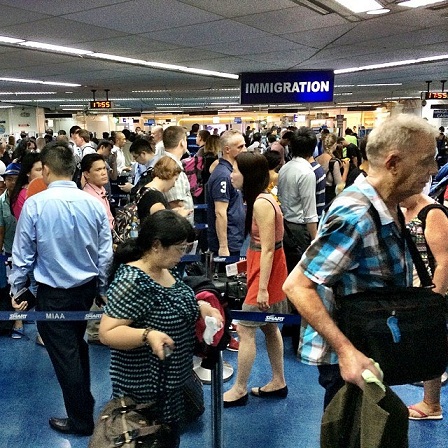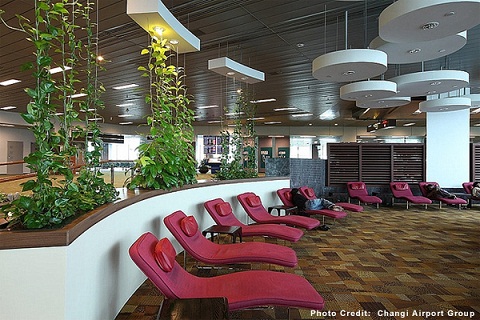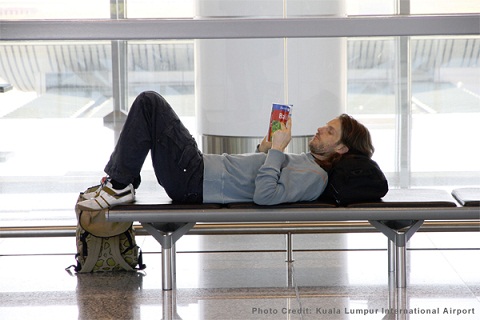
Is anyone surprised that Ninoy Aquino International Airport is once again the topnotcher in the list of worst airports in the world?
The Sept. 30, 2014 post in the website Life Cheat Sheet said “Airports are often an essential and unavoidable part of traveling. Sometimes, you luck out and find yourself in an airport that has minimal wait times and is full of shops, restaurants, and polite staff. Unfortunately, that is not always the case.”
It listed 10 worst airports known for “having rude staff, long lines, poor facilities, and a chaotic environment. “
Life Cheat Sheet website cited NAIA1’s feature that beat competitors hands down: “This Manila-based airport struggles with the 32 million passengers who use its facility each year. That shouldn’t come as a shock, though, considering it only has the capacity for 6 million passengers, according to CNBC.
“Travelers complained about the airport’s rundown facilities, impolite staff and officials, and long wait times. There is, however, some good news for this Philippines airport: CNBC writes that the government there is planning to build a new one, which it hopes to have up and running in five years.”
The other nine in the list are Charles de Gaulle in Paris; LAX in Los Angeles; Bergamo in Italy; La Guardia in New York; Zurich International Airport in Switzerland; Ndjamena in Chad, Africa; Sheremetyevo in Moscow; Bill and Hilary Clinton International Airport in Arkansas; and Netaji Subhash Chandra Bose International Airport in Calcutta, India.
If President Aquino can blithely rationalize the miserable traffic situation as a sign that “the economy is doing well because many vehicles are on the road,” he and his advisers can take a positive spin to the list and say that the Philippines is in good company.
Life Cheat Sheet website did not include the most annoying experience in NAIA which is when arriving flights are told to stay in the air (sometimes as long as one hour) due to aircraft congestion in the airport.
This is not the first time that the NAIA1 has topped the list of bad airports. Last year in the website “Guide to Sleeping in Airports,” it was also number one in the list of worst airports with almost similar four “Cs” criteria as in best and worst airports:
Comfort: crowded terminals or uncomfortable/limited seating;
Conveniences: terminal closes at night, no 24-hour food options or nothing to do on a layover;
Cleanliness: dirty floors, bathrooms or food courts; and
Customer Service: unfriendly staff or anti-airport sleeper policies.
It is worth noting that in both general and sleeping airport categories, the Philippines is the only country in Southeast Asia in that list.
In the list of 10 best airports voted by travellers, Changi Airport in Singapore was number one and number eight was Kuala Lumpur in Malaysia.

The Guide to Sleeping in Airports website said, “While no airport is perfect, the airports on this list (best airports) realize that travellers want more things to do during a layover and they have introduced services and amenities to improve our airport experience such as: Free WiFi, movie theatres, tv lounges, mini-golf, bicycle rentals, gardens, aquariums, art exhibits, and showers. Airports may not have been built with sleeping in mind, but nowadays more of them are implementing rest zones and quiet areas to help us relax on our journeys. We like that!”
This is very helpful for those whose stopover lasts eight to 10 hours.

Travellers cited Changi airport’s special relaxation zones that feature reclining lounge chairs and padded seating and KL airport’s long movable benches that can be pushed and turned into small beds.
Officials of the Department of Transportation and Communication officials said the situation will improve next year when the renovations would have been completed and more airlines would have transferred to NAIA3.
Meanwhile, they can institute some common sense improvements like adding chairs in the waiting area. Two weeks ago, we were at NAIA1 for a 6:00 am flight. There were very few chairs, we had to sit on the floor. It was hot because the airconditioning unit was not functioning and the electric fan was not on.
An improvement: the toilets are new and have more cubicles than before.
Buti na lang dinadaanan lang at hindi final destination yung NAIA. .
Ellen..NAIA is handling a volume of passengers as many as Pearson Toronto (33 millions) with only 2 runways as compares to 5 mains and the roadways to and from the airport which is serve by for Pearson the world’s widest (up to 18 lanes highway 401 and 8 lanes queens highway in the south) and in spring a separate dedicated Express train will be operational that is expected to TAKE OUT up to 2 millions vehicular traffic off the roadways to and from the airport annually. NAIA could only get worse as the volume increases while no plans to improve the Infras or even add more Runways if there is more room.
Otherwise another airport with supporting infras has to be built within the Region.
NAIA is expecting millions of passengers with just a couple of runways and disgusting airport services?
kung tayong mga pinoy nga hindi magawang ipagmalaki ang nararanasan sa ating sariling airport, ‘yung mga dayuhang pumapasyal lamang ang aasahan nilang purihin ang nakakasukang serbisyo ng mga empleyado ng mga kinauukulang ahensiya sa NAIA?
pambihira!
gusto nilang mawala ang tag na one of the worst airports around the globe? subukan nilang magbigay ng libreng shuttle between terminals hindi ‘yung kailangan pang gumastos ng malaki ang mga manlalakbay upang makalipat mula domestic patungo sa international terminal and vice versa.
gobyernong puro dakdak lamang ang alam ng mga henyong opisyal pero pangungurakot ang laman ng utak na walang iniisip kundi pagkakaperahan!
isa sa pinakamagandang airport na nilapagan ko nitong huli akong magbakasyon ay ang kuala lumpur. magandang serbisyo, malinis at maluwag na mga terminal. ihahatid ang mga pasahero patungo sa assigned na terminal ayon sa tiket.
at ang isang magiging kabilang sa mga kahanga hangang airport sa buong mundo ay ang ginagawang King Abdulazziz International Airport sa Jeddah, Saudi Arabia kung saan tatlong sabay sabay na aprons ang itinatayo na may kapasidad na humigit kumulang sa 60 milyong pasahero taon taon at matatapos sa unang bahagi ng 2015.
@Ellen our OFW’s known as “safety valves of the economy” for nth time are feeling angry, confused and lost with the operations of the four (4) terminals at NAIA. For the new would be “economic exiles” whose only option is to go overseas most of them got lost or were left behind by the airline not knowing the exact terminal they will be boarding because of the lack of information where are their aircrafts are park. They are neither tourist nor middle class travelers who can easily pull out an ATM card for a cash to pay for their taxis lest fill-in their rumbling stomachs with the throngs of family members accompanying them for the first time at NAIA.
Within a few hundred thousands of our global Filipinos will be here for the Christmas season and expect more congestion, confusion and whining at the airport when they begin to go back months after with their host country destinations. Effective November 01, 2014 the DOTC/Manila Intl. Airport Authority (MIAA) Memorandum Circular 08 will be implemented where the Intl. Passenger Service Charge (IPSC) called “terminal fee” will be integrated with the airline ticket purchased “online” or via travel agencies.
For first timer OFW’s it is the Phil. Recruitment Agency (PRA) and/or principal/employer/foreign recruitment agency (FRA) who pays for the ticket while vacationing OFW’s two-way tickets are borne by their companies or employers.
Republic Act 8042 (now the amended RA 10022) the Magna Carta Law for our Overseas and Migrant Filipinos exempts our OFWs from paying travel tax and the “terminal fee”. While MIAA MC 08 recognizes this public policy, it was issued purportedly to ease the queuing and congestion. Reality check, it is the limited immigration counters that is causing high traffic maybe due to lack of personnel or non compliance of MIAA’s citizens charter.
But here is the twist of MC 08, OFW’s who were levied this Php 550.00 terminal fee imposition can refund this amount after the immigration counter or allow their relatives to refund the amount at MIAA’s admin office after securing all the requirements for exemption. Unclaimed amounts go to a fund where its mechanics and guidelines as far as its management and operations remain to be spelled out by MIAA authorities.
The so called “modern day unsung heroes of the republic” becomes now a “cash cow” of another GOCC for the nth time aside from being the life blood of OWWA. PHILHEALTH, PAG-IBIG, SSS, POEA, NBI, DFA, NSO where they regularly contribute, on top of their billions of dollars annual remittances to maintain the sanity of this government.
#4 – Pareng Magno, may libreng shuttle service na from NAIA 1 to all other NAIA terminals – umaalis sa NAIA 1 every 10 minutes. Huling alis ko from Manila, NAIA 3 na ang pinanggalingan ko – hindi hamak na mas maganda, mas maluwag, mas maginhawa at mas may sistema kaysa NAIA 1.
#6 – Hindi ko pa naman naranasang magbayad ng travel tax at terminal fee tuwing lumalabas ako ng ‘Pinas. Basta may OEC naman exempted na. Si Misis at ang mga bata lang ang nagbabayad ng terminal fee at travel tax (discounted at P500 each, dahil dependent ko sila).
NAIA 1 is the worst? My experience tells me otherwise – mas malala ang NAIA 2.
http://upexpress.com/en/project/project.aspx
One of the more than 200 projects on progress by the Metorlinx is just about done and here is the link…
It’s been a dream of Torontonians – not to mention time-crunched travellers to the city – for decades. That dream is now finally taking shape, as construction of an air-rail link between Toronto Pearson International Airport and Union Station in downtown Toronto is under way. Here are a few details on one of the most ambitious – and important – transportation projects in the province’s history.
The UP Express trip between Union Station and Toronto Pearson Airport is only 25 km long, and our trains will whisk travelers between Canada’s two largest transportation hubs in just 25 minutes. But first, they must complete a much longer journey from the manufacturing plant in Nagoya, Japan to Toronto (via the Panama Canal, Georgia and Illinois) – a total trek of roughly 20,000 km! Find out more…
And the Trains have Arrived…and the North America second Best Airport will now be welcoming Guests with its new state of the Art UP express Trains as soon as they get out of the departure of the Area to Union Station to seamlessly connect to any mode of Transporation to their final destination…by Springtime and in Time for the Pan American Games this July ,Summer of 2015…
Sumitomo of Japan already delivered Two units of multiple cars Diesel Trains and 18 more units are undergoing final testing in Japan..These units are convertible to Electric and will be converted along with other Trains within the 10 years Electrification Programs, including the long hauls…for the sake of the Environment…Even though these these units passed the Stringent environment Tests by the Govt…These 20 Units will be dedicated for the UP line only…a 25 kms run between Union Station Downtown and Pearson Toronto Airport, the Two Biggest Transportation hubs in the country serving equally about the same volume of passengers..33 millions/year..
sinong namumuno sa alinmang bansa sa buong mundo ang parang batang sumalubong sa paglapag sa airport ng pinakamalaking commercial plane sa buong mundo?
meron ba maliban sa ating PINAKAMAMAHAL na pangulong noynoy aquino?
ano’ng buti sa kanyang pamumuno at karangalan sa bansa ang maidudulot ng pagiging asal-batang tulad niyon?